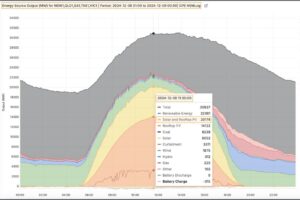The story of Australia’s green energy transition is mostly one of new peaks in output and share of renewables, but there inevitably ups and downs.
The last few days have seen another so-called wind energy “drought” – the second in as many months. Autumn is “traditionally” the season with lowest wind outputs, but the lull this year has pushed the combined output of renewables below its level of last year.
The graph above from ITK Services principal David Leitch, a contributor to Renew Economy and co-host of Renew Economy’s popular and weekly Energy Insiders podcast, shows that the share of variable renewable energy (VRE, or solar and wind), has fallen below last year’s levels.
Another data provider, OpenNEM, puts the share of wind over the last three days at just 4.1 per cent, and five per cent for the past seven days, compared to more than 13 per cent for the past year.
Even in South Australia, which leads the country – and the world – with an average share of 75 per cent wind and solar in the past year, the share of wind energy fell from its year average of 43 per cent to 9.9 per cent in the last seven days.
In Victoria, the share of wind energy fell from a year average of 22.5 per cent to just three per cent in the last three days. In NSW the year long average of 7.5 per cent comped to just 1.8 per cent wind energy in the last three days.
Only Queensland seemed to be doing ok, with an average of 4.6 per cent in the last three days compared to its year average of 4.6 per cent.
That’s interesting for grid planners because while Queensland has little wind capacity so far, it has a lot under construction and this supports the assumption that Queensland wind will be strong in autumn and winter while wind conditions elsewhere might be lower.
Meanwhile, the wind lull is expected to last less than a week in total. Forecasts from AEMO suggest that there will be a fresh burst of wind energy by Wednesday, if not earlier. Australians will need to get used to such highs and lows as the share of renewables grows in the grid: Hence the need for more storage. And more wind and solar.










